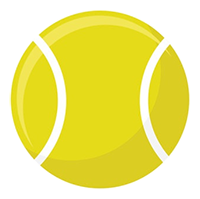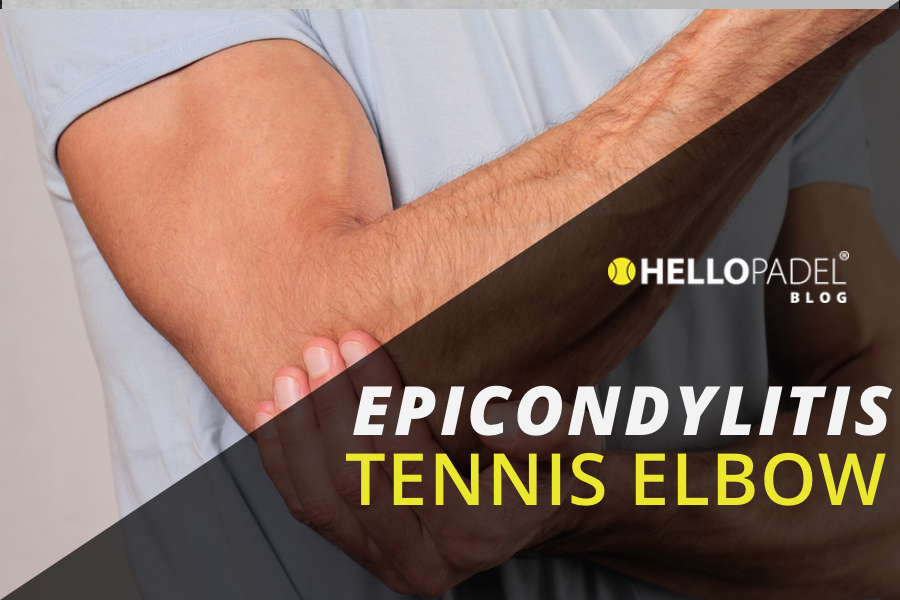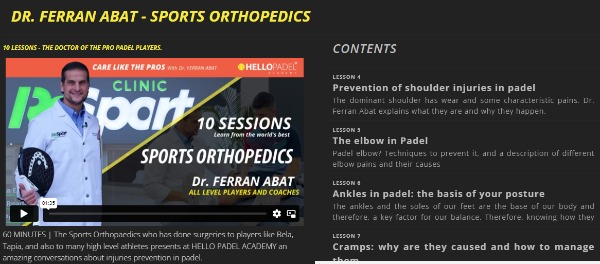1. INTRODUCTION.
Epicondylitis – among the different fears that an athlete may have, the greatest and most widespread fear is probably that of suffering an injury, especially in the case of serious and chronic injuries.One of the most common injuries in the world of tennis and padel, which can affect both amateur and professional athletes, is epicondylitis, also known as “tennis elbow”.
According to several studies, epicondylitis is the third most common injury associated with the practice of padel, with a frequency of 8.5%, only behind ankle sprains (17%) and muscle contractures (14.5%).
In this article we are going to talk about this injury which, unfortunately, is quite common among padel players.
2. WHAT IS EPICONDYLITIS?
As the name “epicondylitis” suggests, it is an inflammation of the tendons that attach to the epicondyle.
Tendons are fibrous connective tissue that attach muscles to bones, and help us to move bones or our structures.
And the epicondyle is a bony bump on the outer side of the underside of the humerus where the tendons of all the supinator and extensor muscles of the forearm attach. This is why this injury is sometimes also called “extensor tendonitis of the wrist”.
This injury, although very common in the sports of tennis and padel, is not an injury exclusive to these sports, but people who carry out other types of activities such as carpenters, mechanics, computer specialists, painters, plumbers, tattooers, weavers, butchers, etc….may also suffer from it.
It is a very annoying injury that can sometimes even become chronic, which is why, if we do not currently suffer from it, we should work on its prevention in order to avoid its appearance.
Although in the vast majority of cases it will be clear that it is epicondylitis, sometimes the pain in the elbow could be caused by epicondylalgia, a problem that causes similar pain in the elbow, but with a very different origin and treatment.
3. POSSIBLE CAUSES OF EPICONDYLITIS
– Overuse or overexertion.
This is probably the most common cause, playing or training too much.
When we play padel, we make a lot of repetitive movements of wrist extension and supination of the forearm when executing the strokes, and this overloading of the forearm muscles can cause small tears and inflammation in the epicondylar tendons causing pain on the outside of the elbow.
– Punching technique.
A bad technique, especially in the in the backhand shot, can favour its appearance. Making a lot of wrist movements in the execution of the strokes, open stance from the back of the court in the backhand strokes or hitting with the arm very close to the body are details that can facilitate the appearance of epicondylitis.
This is why it is important to receive lessons from a professional.
– Playing with a bat that is NOT suitable for us.
We will see in detail which bats are the best for epicondylitis in section 6.
– Changing the racket for another model and/or brand that is very different to the one we had.
In these cases, it is very likely that the arm will need some time to adapt to the new racket, so it would be advisable not to play too much when we have just changed racket and play from less to more time.
– Using a grip that is too fat or too thin for your hand.
Playing with a grip thickness that is not appropriate for the size of your hand makes your forearm muscles work harder.
– Not warming up properly.
– Not stretching after the game.
– Weak forearm muscles.
4. SIGNS AND SYMPTOMS OF EPICONDYLITIS
– Pain on palpation of the epicondyle (outer elbow).
– Discomfort when extending or lifting the wrist.
– Pain on supination of the arm, e.g. turning a door handle.
– Pain when shaking hands with another person when going to greet them.
– Discomfort or pain when making a fist or grasping or lifting an object, e.g. when picking up a glass of water, a bottle or a cup of coffee.
– Loss of strength in the forearm, sometimes very considerable.
– Pain that moves from the elbow to the forearm or upper arm when making certain movements.
– Pain usually subsides at night and at rest.
– In general, the mobility of the elbow is not altered.
Note. The degree of pain can range from mild discomfort to a very acute pain in which it is not even possible to pick up the padel racket.
5. TREATMENTS
1. Rest.
This is undoubtedly the first step to take. We will have to stop playing or, at least, reduce the frequency of playing quite a lot until the symptoms disappear.
If we have to lift objects, it is better to lift them with the palm of the hand upwards to avoid using the lateral epicondyle.
2. Specific warm-up before playing.
It is very important to warm up well before playing, we already talked about warming up in a previous article, but it is absolutely essential to do specific warm-up exercises for the elbow if we suffer or have suffered pain or discomfort in the elbow.
3. Stretching.
Stretching the elbow and wrist flexor muscles after playing is essential.
There are several specific stretches, seen here : https://www.youtube.com/watch?v=uFNhlBR-Ae0&t=31s
4. Ice and heat.
Apply cold for 15 minutes every hour for the first 48 to 72 hours after feeling pain or discomfort until it disappears. Always alternate this with stretching of the wrist flexor muscles.
After 48 hours, the area can be treated with heat, but always keep stretching.
5. Mobilisation and strengthening exercises.
It is advisable to perform specific mobilisation and strengthening exercises to prevent its appearance.
There are several exercises that can be done.
6. Self-massage.
It is also possible to self-massage the elbow to relieve and/or prevent epicondylitis.
7. Braces or elbow pads.
Placing a brace around the forearm, just below the elbow, can prevent the forearm muscles from vibrating and causing pain in the epicondyle area.
However, according to Javier Munain, perhaps one of the best physiotherapists in the tennis world, comments in a video that this accessory does not always work for everyone. So, what he recommends is to always try it and see if it works.
And as for the elbow pad, its main objective or purpose is to warm up the joint, as pain is felt more when we are cold than when we are warm. For this reason, Javier Munain recommends wearing it between 30 minutes and 1 hour before starting to play.
8. Neuromuscular or kinesiological bandages.
This type of bandage can be used to treat different types of ailments and pathologies. They help muscle function, but without limiting movement, maintaining adequate blood and lymphatic circulation, which facilitates the body’s natural healing process
9. Medications.
Taking non-steroidal anti-inflammatory drugs to reduce pain and inflammation in the area can help. In any case, however, they should never be abused and, if in doubt, always consult a doctor.
10. Physiotherapy.
If the symptoms do not improve with all of the above, you will almost certainly need to receive several sessions of physiotherapy.
Some valid treatments would be: dry needling, electrotherapy (diathermy, TENS, interferential currents, ultrasound or laser), neuromuscular bandage or kinesiotape, local heat, massage techniques, shock waves…
11. Corticoid injection.
Corticoid injections are very effective in eliminating episodes of pain for weeks or months, however, discomfort tends to reappear over time if the problem that caused it is not solved.
12. Surgery.
And then, in the most serious cases where all of the above has not worked, perhaps the only solution would be surgery.
Note. As a general rule, and in most cases, the symptoms will disappear one or two weeks after starting the treatment(s).
6. BEST TYPE OF RACKET TO “AVOID” EPICONDYLITIS
“As a general rule, we could say that there are no good or bad rackets, but rather rackets that, depending on our personal characteristics and level of play, are suitable or unsuitable for us.
So, if we suffer from epicondylitis, the best types of bats to use are those with the following characteristics:
– Round shape.
These bats have a lower balance, that is, more towards the fist, which makes them easier to swing and less demanding for the arm. Avoid big-headed blades, which are diamond-shaped blades with a high balance.
– Large sweet spot. The larger the sweet spot of a racket, the less vibrations it will transmit to the arm.
– Light or rather low weight.
It is not advisable to use blades that are too heavy for your arm, even if they are not diamond-shaped and have a low balance. This way we will avoid overloading the arm.
– Soft rubber core.
It is better to use soft blades, for example, those that use FOAM rubber. This will give us a very good ball exit without having to exert much force with the arm while better absorbing the vibrations that occur when hitting the ball.
– Anti-vibration system.
Nowadays, there are many brands of paddles that incorporate a system that absorbs or reduces the vibrations that reach our arm when hitting the ball.
7. CONCLUSION
Although this is a very common injury in padel, we have also seen that, in the vast majority of cases, this usually has a good prognosis for healing, being able to heal fairly easily and quickly following several of the appropriate treatments that exist.
In addition, we have also seen that several of the main causes that can lead to the appearance of this injury: playing too much, not doing a specific warm-up, not stretching the forearm muscles, playing with an inadequate racket for us, not playing with a correct grip thickness… are totally avoidable since they depend only on us.
Therefore, the good news is that, if we do the things we should and we do them well, in many cases we will be able to avoid this injury.
So, for our part, we encourage you to always carry out all (or as many as possible) of the guidelines recommended in this article so that you can escape this injury and continue playing and enjoying our favorite sport with the maximum possible safety.
LEARN MORE ON FITNESS AND PADEL: HERE
 Upgrade now
Upgrade now






